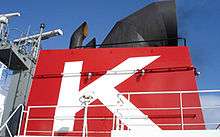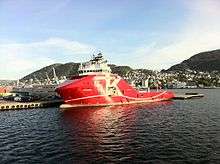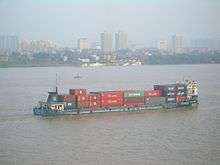K Line
Kawasaki Kisen Kaisha, Ltd. (川崎汽船株式会社, Kawasaki Kisen Kabushiki-gaisha, branded as "K" Line, stylized as "K" LINE) is a Japanese transportation company. It owns a fleet that includes dry cargo ships (bulk carriers), container ships, liquefied natural gas carriers, Ro-Ro ships, tankers and container terminals. It is the fourteenth largest container transportation and shipping company in the world.
 | |
| Public KK | |
| Traded as | TYO: 9107 NAG: 9107 FSE: 9107 |
| ISIN | JP3223800008 |
| Industry | Transport |
| Founded | 1919 |
| Founder | Kojiro Matsukata |
| Headquarters | , |
| Subsidiaries | International Transportation Service |
| Website | www |

-2005.jpg)
History
1919-1944

K Line traces its origin to Kawasaki Heavy Industries, Ltd, which itself was born in 1878, when founder and entrepreneur Kawasaki Shōzō (川崎 正蔵) established Kawasaki Tsukiji Shipyard in Tokyo, Japan, which, eighteen years later, in 1896, was incorporated as Kawasaki Dockyard Co., Ltd.
The shipping activities were developed when Kawasaki Dockyard Co., Ltd. (predecessor of Kawasaki Heavy Industries)'s President Kojiro Matsukata, decided to develop shipping services so as to provide business to Kawasaki Dockyard and to serve Japan's national industrial and trade interests.[1]
To do so, he placed Kawasaki Kisen, Kawasaki Zosen and Kokusai Kisen under joint management to build a stronger fleet of 40 to 50 ships serving the Atlantic, North and South America, Africa and the Mediterranean and Baltic Seas.
In 1921, the joint name 'K Line' was adopted, based on the initial of the three companies.
K Line founder, Kojiro Matsukata, was also known as an art collector. The National Museum of Western Art in Tokyo's Ueno Park was established around the core of Matsukata's private collection. In addition, the Tokyo National Museum houses his extensive collection of Ukiyo-eprints.[2]
In 1926, according to Lloyds, the newly established "K" Line reached the rank of 13th in the world, behind compatriots NYK (9th) but ahead of O.S.K. (14th).
By the end of World War II, Kawasaki Kisen had lost 56 vessels; 12 survived.
Prior to World War II, the holding company Kawasaki Heavy Industries was part of the Kobe Kawasaki zaibatsu, which included Kawasaki Steel and Kawasaki Kisen. After the war, KHI became part of the DKB Group (keiretsu).
1945-1961
During that vital recovery period, "K" Line steadily returned to the building and operation of ships, reestablished bases of operation around the world, increased earnings and took other steps to restore corporate strength and vibrancy of the company.
1962-1967
After the merger with Iino Kisen, "K" Line was newly capitalized at ¥9 billion and controlled a fleet of 104 ships, 55 of which were also owned by "K" Line. The merger gave "K" Line a solid foundation to advance dynamically into the future both as one of the world's largest shipping lines in terms of fleet size and as a well-balanced, integrated organization.
1971
K Line opens International Transportation Service, a container terminal company in the Port of Long Beach.
The Car Carrier transport division was inaugurated with the launch of the new Roll-on/roll-off vessel Toyota Maru No. 10. K-Line would thereafter enlarge the fleet up to 70 Car carriers vessels. All owned RORO vessels started to include in the first part of their names the word “Highway” (opposite to its container fleet’s vessels that include the word “Bridge” into their names), to symbolize a link in between Japan and the rest of the world served by sea.[3]
2003
KESS - K Line Europe Short Sea is inaugurated in July 2003 in Germany, as a dedicated feeder operator in Europe specialized in brand new cars shipping in between European, Scandinavian, Baltic and Mediterranean ports.[4] The company tonnage is composed of 11 Roll-on/roll-off ships.
2007

K Line Offshore AS was founded in Arendal, Norway in October 2007 as a subsidiary of K Line to provide offshore support services to oil and gas fields. They have commissioned new ships suitable for oil and gas fields in ultra-deep water, harsh environments and/or remote areas. They operate the following ships:
- KL Arendalfjord - Delivered 24 October 2008
- KL Brevikfjord - Delivered 24 September 2010
- KL Sandefjord - Delivered 7 January 2011
- KL Brisfjord - Delivered 13 January 2011
- KL Brofjord - Delivered 5 April 2011
- KL Saltfjord - Delivered 14 April 2011
- KL Barentsfjord - Delivered 28 June 2011
On September 30, 2007, Shuichiro Maeda, K-Line president, said the company will build 10 cargo ships to be manned by an all-Filipino officers and crew. The vessels are expected to be finished by 2010. It will employ 7,000 Filipinos in the next 4 years (3,330 officers and 3,600 ratings or crew). K-Line will build the K-Line Maritime Academy-Philippines operational in February 2008 and is intended to train at least 10,000 seafarers a year.[5]
2017
In 2017, K Line, Nippon Yusen (NYK) and Mitsui O.S.K. Lines (MOL) announced that they would merge and jointly operate their global container shipping services as Ocean Network Express (ONE), in order to better compete against other global container shipping groups. ONE would merge all container shipping services of the three companies, as well as their port terminal operating subsidiaries in various countries, except in Japan, while keeping their other shipping services separate. ONE began operations on April 1, 2018.[6][7] Its holding company office is based in Tokyo, with global headquarters in Singapore and regional headquarters in: London, United Kingdom; Richmond, Virginia; and São Paulo, Brazil.
2018
On 23 July, KESS car carrier Makassar Highway[8] ran hard aground at full speed in the Tjust archipelago near Loftahammar, Sweden, causing an oil spill.[9][10] By his own account, the captain had ordered a course close to land, far from established shipping lanes, in order to gain mobile phone reception. The ship's satellite communication system and black box were inoperable when departing Cuxhaven for Södertälje, and alarm systems had been disabled.[11] The Swedish Coast Guard recovered approximately 7,000 litres (1,500 imp gal; 1,800 US gal) of oil by 30 July,[12] but thousands of litres of oil nevertheless washed up on the coast.[13] An estimated 14,000 litres (3,100 imp gal; 3,700 US gal) of oil were spilled.[10][14] The ship was towed to Oskarshamn, where its cargo of 1,325 vehicles were offloaded. The chief mate was taken into custody and accepted a fine for intoxication and recklessness in maritime traffic.[15][16] His blood alcohol content by mass at the time of the accident was estimated at 1.15 permille, based on samples taken after the accident.[17] The oil spill is also being investigated as an environmental crime.[14]
.jpg)
2019
On 15 June 2019, car carrier Diamond Highway caught fire while sailing in between the ports of Singapore and Batangas.[18]
Philippines Coast guard was alerted, and a mission to rescue the 25 members of the Crew was undertaken by another car carrier sailing in proximity.[19]
The ship had to be abandoned, and later towed to dry dock.
The reason why the fire broke out is unknown, but possibly related to the cargo on board.
Others
- "K" Line Air Service, Ltd. changed name into "K" Line Logistics, Ltd.
- "K" Line Travel, Ltd.
- KESS - "K" Line European Sea Highway Services
References
- "History" (PDF). Kline.co.jp.
- "History". Global.kawasaki.com.
- "K Line cuts chartered fleet". Wall Street Journal. Retrieved 2020-01-02.
- "News". Cmport.com.
- "Japan firm builds 10 ships to be manned by Filipinos". GMA News Online.
- Lopzez, Edwin (May 31, 2017). "Japanese shippers K Line, MOL, NYK to merge as ONE". Supply Chain Dive.
- MI News Network (April 2, 2018). "ONE – Integration Of K-Line, MOL & NYK Commences Shipping Services". MarineInsight.
- "Vessel details for: MAKASSAR HIGHWAY (Vehicles Carrier)". MarineTraffic. Retrieved 2 August 2018.
- Chambers, Sam (24 July 2018). "K Line car carrier hard aground in southern Sweden". Splash 247. Retrieved 2 August 2018.
- "Swedish coast guard works to clean up 14,000-litre oil spill". The Local. 30 July 2018. Retrieved 2 August 2018.
- "Nya uppgifter: Fartyget hade trasigt kommunikationssystem" [New details: The ship's communication system was broken]. Swedish Television (in Swedish). 1 August 2018. Retrieved 2 August 2018.
- Jiang, Jason (30 July 2018). "Oil spill detected as K Line car carrier refloats". Splash 247. Retrieved 2 August 2018.
- Jiang, Jason (1 August 2018). "Leaking K Line car carrier under tow". Splash 247. Retrieved 2 August 2018.
- ""En fullständigt vansinnig kurs"" ["A completely insane course"]. Barometern (in Swedish). 2 August 2018. Retrieved 2 August 2018.
- "Tidslinje för Operation Makassar Highway" [Timeline for Operation Makassar Highway]. Swedish Coast Guard (in Swedish). August 2, 2018. Retrieved 2 August 2018.
- "Skandalen Makassar Highway – dag för dag" [The scandal of Makassar Highway – day by day]. Dagens Nyheter (in Swedish). 2 August 2018. Retrieved 2 August 2018.
- Karanikas, Mikael; Zachau, Jörgen (9 July 2019). Slutrapport RS2019:04 [Final Report RS2019:04] (PDF) (Report) (in Swedish). Swedish Accident Investigation Authority. Retrieved 9 July 2019.
- Williams2019-06-19T12:58:00+01:00, Marcus. "Fire on K-Line car carrier forces crew to abandon ship". Automotive Logistics. Retrieved 2019-11-19.
- "Abandoned car carrier adrift UPDATE Jun 17". FleetMon.com. Retrieved 2019-11-19.
